The Chameleon Brush  copies a fragment of an image from one part to another with respect to the color range, tone, texture, illumination, and other characteristics of the background, to which the clone is applied. Unlike the Clone Stamp tool, this preserves the characteristics of the background, adapting the cloned object to a new environment. Cloning can be performed within the same layer, between different layers, or between loaded images.
copies a fragment of an image from one part to another with respect to the color range, tone, texture, illumination, and other characteristics of the background, to which the clone is applied. Unlike the Clone Stamp tool, this preserves the characteristics of the background, adapting the cloned object to a new environment. Cloning can be performed within the same layer, between different layers, or between loaded images.
To clone an object first choose Chameleon Brush from the left, and select an image source by holding down Alt (Option on Mac), and click the left mouse button over the area from which the cloned fragment will be selected.
Once the reference point is defined, move the cursor to another location. To place the cloned fragment click the left mouse button. When the left mouse button is released, a cross-shaped cursor will appear over the source area, to indicate from where the clone fragment is selected.
Note: The sample can be selected from any type of layers, but copied only to a raster layer.
Attention! On Linux, by default, the system intercepts Alt+click to move a window with the mouse. For the Chameleon Brush tool, you can use Alt+Ctrl or change the system settings and set a different keyboard shortcut for moving the window.


The basic tool settings are shown in the Tool Options panel above the Image Window or by right-clicking on the image. To display the full list of parameters, press the tool icon in the Tool Options panel or use the F5 key. To specify the parameter settings, enter a numerical value in the parameter’s field or use the slider.
Element - in the drop-down list, select the type of the basic element of the brush: Ellipse or Select Shape.
Size (1-5000). Diameter of the source area, from which the fragment is cloned (in pixels).
Fill (1-100). The opacity of the clone in a single brush stroke. When applying strokes to each other, the opacity of the clone increases.
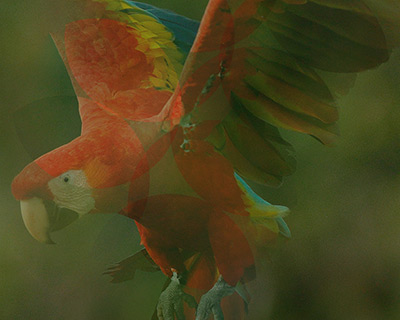 Fill = 25
Fill = 25
 Fill = 75
Fill = 75
The Aligned check-box sets the cloning method. When the check-box is enabled, one clone is created from an area: in this case each new line draws information from the relevant area around the source point. When the check-box is deactivated, each time the mouse button is clicked, a cross-shaped cursor will appear above the source area, and new lines will create a clone from only this area.
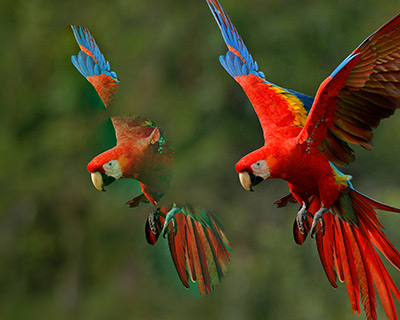 Aligned check-box is enabled
Aligned check-box is enabled
 Aligned check-box is disabled
Aligned check-box is disabled
Sample. Set a source for the sample:
Current Layer - active layer data,
Current & Below - data from the active and all visible underlying layers,
All Layers - data from all visible layers.
Clone Source settings  . The changes are applied when the settings menu is closed: by pressing the Enter key or by clicking anywhere in the program window.
. The changes are applied when the settings menu is closed: by pressing the Enter key or by clicking anywhere in the program window.
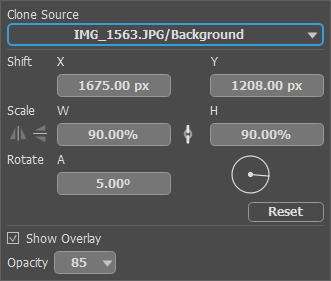 Clone Source Settings
Clone Source Settings
You can set up to five different patterns in the drop-down list and switch between them. The selected samples are stored in the list as "document name/layer name" until the source (document or layer) is closed. To add a new sample, select an "empty" list item, switch to the image and, holding down the Alt key, set a new source point. If, when adding a new clone point from an image, an existing sample is selected in the list, it will be overwritten.
Transformation of the cloned area. For each sample in the list there are separate transformation settings:
Shift. In the X and Y fields, you can specify the coordinates of the starting point for copying the sample. The values will be set automatically when selecting the source point with the Alt key pressed.
Scale. The size of the clone relative to the original fragment. In the W and H fields, you can set new scale values. To maintain the clone's proportions, close the link icon  .
.
 Clone Scaling (Left to Right: 30%, 60%, 100%)
Clone Scaling (Left to Right: 30%, 60%, 100%)
Flip Horizontal  . The command allows a clone to be mirrored along the standing axis, i.e. interchanging the left and right sides.
. The command allows a clone to be mirrored along the standing axis, i.e. interchanging the left and right sides.
Flip Vertical  . The command mirrors a clone by turning it upside down.
. The command mirrors a clone by turning it upside down.
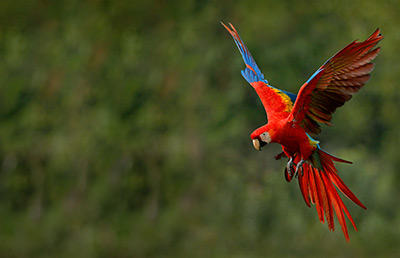 Original Image
Original Image
 Regular Clon
Regular Clon
 Flip Horizontal
Flip Horizontal
 Flip Vertical
Flip Vertical
Rotate. Rotation of the cloned area.
Reset. Press the button to return the transformation settings to the original ones.
Sample Preview:
Show Overlay. When the check-box is enabled, the copied area of the image will be displayed inside the cursor.
Opacity. The parameter allows you to change the transparency of the sample inside the cursor.
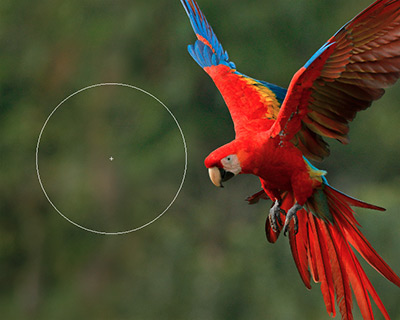 Check-Box is Disabled
Check-Box is Disabled
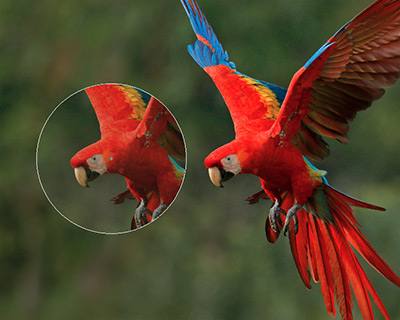 Check-Box is Enabled
Check-Box is Enabled
The Artistic Cloning mode temporarily disables the consideration of the neighboring pixels when applying a clone fragment. In this mode, you can change the brush size, choose a new source from which to copy a clone, remove parts from a clone area, etc. To remove a part of the clone, press the Ctrl-key on the keyboard (⌘ on Mac) and, keeping it pressed, draw over the area.
This mode is useful when cloning from a large image or creating a clone from different parts of an image.
To process the fragment and close the Artistic Cloning mode, you can use one of the methods:
- press the button  in the Tool Options panel,
in the Tool Options panel,
- disable the Artistic Cloning check-box in the Tool Options panel, or
- press the Exit AC Mode button ![]() in the History panel.
in the History panel.
To exit the Artistic Cloning mode without applying the changes, click  in the Tool Options panel.
in the Tool Options panel.
Note: When using the Artistic Cloning mode, only the actions performed in this mode are displayed in the History panel. When you exit the mode, the full image processing history will be restored.
In addition to the above-mentioned parameters, you can adjust the advanced settings that affect the shape and position of the clone.
Press the Default button to set all settings to their default values.
To draw a straight line, first specify the starting point with the left mouse button, then, while keeping Shift pressed, move the cursor to the desired end point of the line and release Shift. If Shift is not released, a new line will be drawn to each point where the mouse is clicked.
